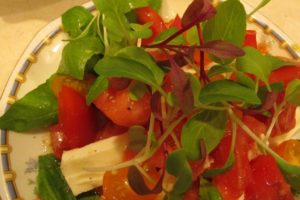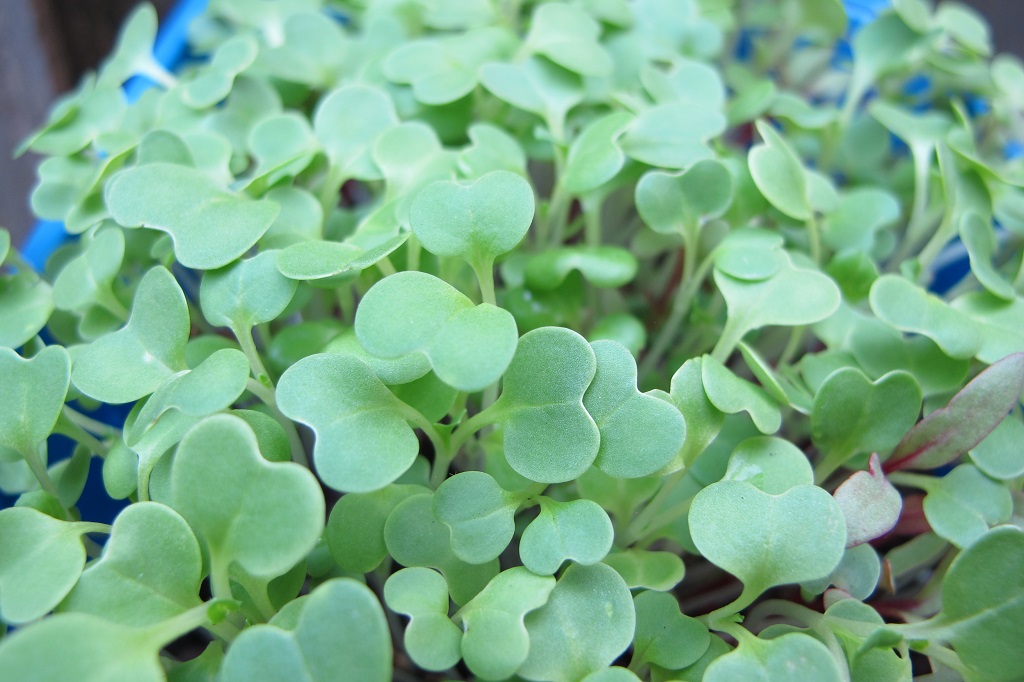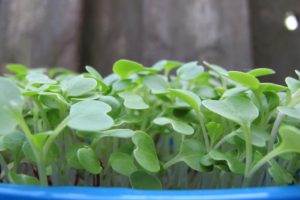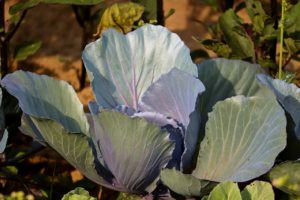2020
Updated 9/24/2024
Mmm…Microgreens!
Here’s an easy way to grow nutrient-dense plants in a tiny space without lifting a trowel. Have you ever tried growing microgreens? This is such a simple method of incorporating the most concentrated sources of antioxidants and other nutrients into your diet.
Maybe you’re not sure about all those supplements in the health food store, and you want to go the more natural route. Besides, the experts tell us, vitamins, minerals, and antioxidants are best obtained from a wide variety of foods, including fresh fruits and vegetables.
Eating from several of the plant families ensures that we get a diverse assortment of nutrients. Greens provide a hefty helping of antioxidants, vitamins, and minerals, but missing from the plant world is Vitamin B-12. This is of particular concern among vegetarians.
Vitamin B-12 is found in seafood, meats, dairy, and fortified cereals. Because I don’t eat red meat at all, and other animal proteins only a few times per week, I take Vitamin B complex, among a few other supplements.
If you have any questions, ask your health care professional.
Why Are Microgreens So Good For Us?
Certain nutrients have gained prominence over the past decades, as research suggests their efficacy in maintaining good health. Although not among the basic food categories needed for survival (carbohydrates, fats, protein, vitamins, and minerals), these substances help us fight or prevent many serious illnesses, including cancer. Phytonutrients, polyphenols, prebiotics, and antioxidants—oh, my! Sure, it can be confusing.
Research indicates that microgreens have between 4 and 40 times more nutrients than a similar amount of the full-grown crops. That’s all it took to convince me!
Seed suppliers sell individual varieties as well as mixtures. Accordingly, they’ll vary in color and flavor. The mixtures I use are primarily composed of the brassicas, and here’s why…
The Brassicaceae Family

Arugula ‘Astro’ seedlings.
Let’s start with the First Family of Plant Nutrition, the cabbage and broccoli relatives, or the mustard family. Plant taxonomists changed the name of this family from Cruciferae to Brassicaceae (“brass·i·kay’·see·ee”), but the terms cruciferous vegetable, brassica, and cole crops refer to the same group of plants. These brassicas have uniquely beneficial properties that set them apart from other plant families.
I’ve written many times in The Farm In My Yard about the health benefits of these plants. If you do just one thing to improve your diet, start with the brassicas. It helps that these microgreens are really easy to grow—and fast!
This family comprises many types of super-healthy plants. I include at least one in my diet every day: arugula, broccoli, Brussels sprouts, cabbage, cauliflower, collards, kale, mizuna, mustard greens, pac choi, radish, tatsoi, turnip greens, and others. Nasturtium, another brassica, can be grown as shoots.
I’ll prepare the broccoli, for example, steamed, in a stir-fry, or lightly cooked with garlic, olive oil, and mushrooms. Brassicas make healthful additions to pasta dishes, homemade or store-bought soups, pizza, omelets, salads, smoothies, and sauces.
You can harvest brassicas grown as microgreens within 3-4 weeks of sowing. Give them at least 6 hours of direct sunlight for optimal growth. With less than ideal conditions, you’ll still be able to harvest greens, but they’ll take longer to grow and they might lack some color. For the full complement of phytonutrients, though, give them sun.
Health Benefits of the Brassicas
Adopting a healthy lifestyle presupposes dropping some bad habits and incorporating those that contribute to greater longevity. Adding half a cup of microgreens might not negate the harm done by smoking or your daily dose of mac and cheese, but it’s a start. Consuming foods from the brassica group helps:
- reduce inflammation
- slow the aging process (skin, eyes, joints, brain, vascular system)
- reduce the chances of getting age-related macular degeneration and cataracts
- reduce the risk of cancer, heart disease, type 2 diabetes, dementia
These greens and vegetables contain varying amounts of Vitamins A, B complex, C, E, and K. They contain calcium, fats (Omega-3), fiber, folate, iron, magnesium, manganese, potassium, protein, zinc, and more. Some of these nutrients are among the dozens of types of antioxidants, which neutralize potentially harmful free radicals.
What Are Free Radicals?
Remember learning about atoms, electrons, and protons? Well, here’s a summary:
The atom contains protons and neutrons in the positively-charged nucleus. The nucleus accounts for more than 99.9% of the atom’s mass. Surrounding the nucleus are the orbits, or shells, which hold the negatively-charged electrons. Up to two electrons fill the inner shell (“1 shell”), up to eight electrons fill the next shell (“2 shell”) and other shells contain up to 2 times the square of the shell number.
The number of protons (equal to the atomic number in the periodic table) distinguishes oxygen from carbon or sulfur or any other element. A stable atom, one that is inert, has an equal number of protons and electrons. Atoms of different elements bond together to form molecules, such as sugar, proteins, and water.
In order to become stable, atoms must complete their outer shells. They do that by stealing one or more electrons from, or giving them to, another atom. The outer shell is where chemical reactions with other atoms take place. Chemical bonds hold the atoms together. When weak bonds split between atoms or molecules, free radicals are formed.
These unstable free radicals seek to steal electrons from nearby molecules. This sets up a chain reaction of instability—one molecule stealing from another molecule—causing oxidative stress. This cascade of interactions is what can damage our cells. Cancer and other inflammatory diseases can begin if the disruption occurs near cell nuclei or membranes.
Those free radicals form in response to stresses in our bodies, including pollutants and toxins in our cells and bloodstream, and enzymes present in the normal process of digestion. We are healthier if there are more antioxidants than free radicals in our systems.
What Are Antioxidants?
Antioxidants are substances that prevent oxidative stress and reduce inflammation. They can be vitamins, minerals, or any of the many thousands of phytonutrients. Deep green, red, orange, and other colorful plant pigments are loaded with antioxidants.
Vitamin E is the most abundant fat-soluble antioxidant. It helps protect us from heart disease by limiting LDL (low-density lipoprotein) oxidation and plaque formation.
Vitamin C is the most abundant water-soluble antioxidant. It, too, donates electrons to free radicals, ending the damaging cascade of instability. Vitamin C shows promise in the fight against cancer, especially types that affect the mouth, larynx, and esophagus. (Discuss diagnoses and treatments with your doctor.)
In recent studies, researchers used isotopes to track the uptake of these nutrients. They associate antioxidants, such as beta-carotene, lutein, and lycopene, with possible avenues of cancer treatment.
Glucosinolates
Phytonutrients are a major category of nutrients found in the brassicas. Of particular interest among this group are the glucosinolates, which include sulforaphanes. These substances are not found in significant amounts—or at all—in any other family of plants. These compounds, numbering more than 100 kinds, are key players in lowering the risk of cancer and inflammatory diseases. Different phytonutrients are found in brassicas eaten raw and in those which are cooked.
That’s why this is my go-to vegetable family. Every day. While preparing these greens for cooking, I also eat a few raw pieces. When possible, I’ll cut or chop the broccoli or kale (or any brassica) and let it rest on the kitchen counter for 30-60 minutes, so the enzyme, myrosinase, can start transforming precursors of sulforaphanes into the sulforaphanes themselves in the damaged plant cells. Heat destroys this essential enzyme, so we would miss out on those powerful sulforaphanes if we cooked the greens right away. Eating raw brassicas, however, also delivers the benefit of sulforaphanes. Broccoli sprouts contain the highest amounts of these beneficial nutrients.
Before you think you’re protected because of the three little broccoli florets you just had with your steak dinner, think again. Consider making brassicas and other vegetables the main attraction, and using chicken, beef, or pork as condiments. If this is too big a leap, try adding more vegetables and decreasing the amount of meat consumed over time. Baby steps are better than not moving at all.
Other Plant Families for Microgreens, Sprouts, or Shoots
The Amaranthaceae Family
Amaranth, beets, quinoa, spinach, and Swiss chard are members of this family. Because of the higher oxalate content in this group, check with your doctor if you’re prone to kidney stones. Lots of pigments are found in amaranth, beet greens, and ‘Bright Lights’ Swiss chard, adding color to your clippings.
The Amaryllidaceae Family
The onion group, which also includes garlic, green onion, leeks, and shallots. Seedlings are very finely textured and take longer to grow.
The Apiaceae Family
Many useful herbs and vegetables belong to this family: carrot, chervil, cilantro, celery, cutting celery, dill, fennel, parsley. All can be grown as microgreens.
The Asteraceae Family
This group includes endive, the lettuces, single marigold (the ‘Gem’ series), radicchio, and sunflowers. Look for varieties that have red pigments, which have more anthocyanins. Anthocyanins are powerful antioxidants.
Grains and Legumes
Barley, oats, rice, winter wheat; alfalfa, chickpeas, lentils, mung beans, pea and pea tendrils.

Microgreens on caprese salad.
The Lamiaceae Family
Mint, anise hyssop—minty anise flavor; basil—many colors and flavors, including cinnamon, sweet, lemony.
The Polygonaceae Family
Sorrel, red-vein sorrel.
Headings
Page 1: Mmm…Microgreens!, Why Are Microgreens So Good For Us? (The Brassicaceae Family, Health Benefits of the Brassicas, What Are Free Radicals?, What Are Antioxidants?, Glucosinolates), and Other Plant Families For Microgreens, Sprouts, or Shoots
Page 2: What Are Microgreens?, What Are Shoots?, What Are Sprouts?, and How To Grow Microgreens, (How To Use Microgreens, The Container, The Soil, The Seeds, Maintenance, Yellow Leaves?)


